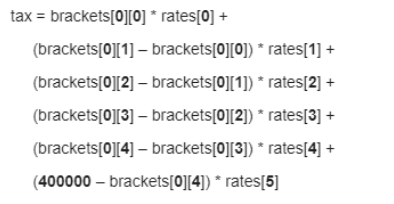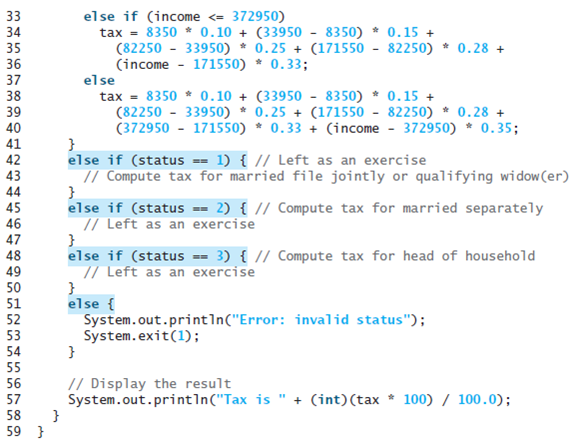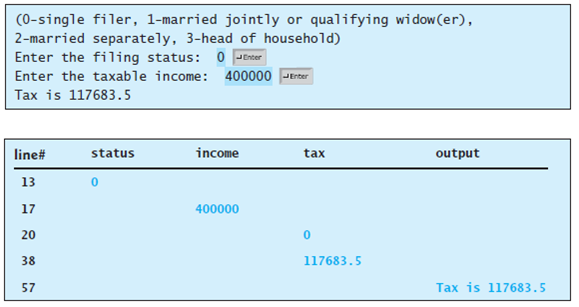Programming Exercise 8.12 writes a program for computing taxes using arrays. Design a class named Tax to
Question:
Programming Exercise 8.12 writes a program for computing taxes using arrays. Design a class named Tax to contain the following instance data fields:
For each filling status, there are six tax rates Each rate is applied to a certain amount of taxable income. For example, from the taxable income of $400,000 for a single filer, $8,350 is taxed at 10%, (33,950 - 8,350) at 15%, (82,250 - 33,950) at 25%, (171,550 - 82,550) at 28%, (372,550 - 82,250) at 33%, and (400,000 - 372,950) at 36%. The six rates are the same for all filling statuses, which can be represented in the following array:
double[] rate = (0.10, 0.15, 0.25, 0.28, 0.33, 0.35);
The brackets for each rate for all the filling staruses can be represented in two dimensional array a follows:
int[][] brackets = { ?{8350, 33950, 82250, 171550, 372950}, // Single filer {16700, 67900, 137C
Suppose the taxable income is $400,000 for single filers. The tax can be computed as follows:

Listing



? int filingStatus: One of the four tax-filing statuses: 0?single filer, 1? married filing jointly or qualifying widow(er), 2?married filing separately, and 3?head of household. Use the public static constants SINGLE_FILER (0), MARRIED_JOINTLY_OR_QUALIFYING_WIDOW(ER) (1), MARRIED_SEPARATELY (2), HEAD_OF_HOUSEHOLD (3) to represent the statuses.??int[][] brackets: Stores the tax brackets for each filing status.??double[] rates: Stores the tax rates for each bracket.??double taxableIncome: Stores the taxable income.Provide the getter and setter methods for each data field and the getTax() method that returns the tax. Also provide a no-arg constructor and the constructor Tax(filingStatus, brackets, rates, taxableIncome).Draw the UML diagram for the class and then implement the class. Write a test program that uses the Tax class to print the 2001 and 2009 tax tables for taxable income from $50,000 to $60,000 with intervals of $1,000 for all four statuses.The tax rates for the year 2009 were given in Table 3.2. The tax rates for 2001 are shown in Table 10.1.
Marginal Tax Rate |
Single |
Married Filing Jointly or Qualifying Widow(er) |
Married Filing Separately |
Head of Household |
10% |
$0 ? $8,350 |
$0 ? $16,700 |
$0 ? $8,350 |
$0 ? $11,950 |
15% |
$8,351 ? $33,950 |
$16,701 ? $67,900 |
$8,351 ? $33,950 |
$11,951 ? $45,500 |
25% |
$33,951 ? $82,250 |
$67,901 ? $137,050 |
$33,951 ? $68,525 |
$45,501 ? $117,450 |
28% |
$82,251 ? $171,550 |
$137,051 ? $208,850 |
$68,526 ? $104,425 |
$117,451 ? $190,200 |
33% |
$171,551 ? $372,950 |
$208,851 ? $372,950 |
$104,426 ? $186,475 |
$190,201 ? $372,950 |
35% |
$372,951+ |
$372,951+ |
$186,476+ |
$372,951+ |
Step by Step Answer:

Introduction to Java Programming, Comprehensive Version
ISBN: 978-0133761313
10th Edition
Authors: Y. Daniel Liang





